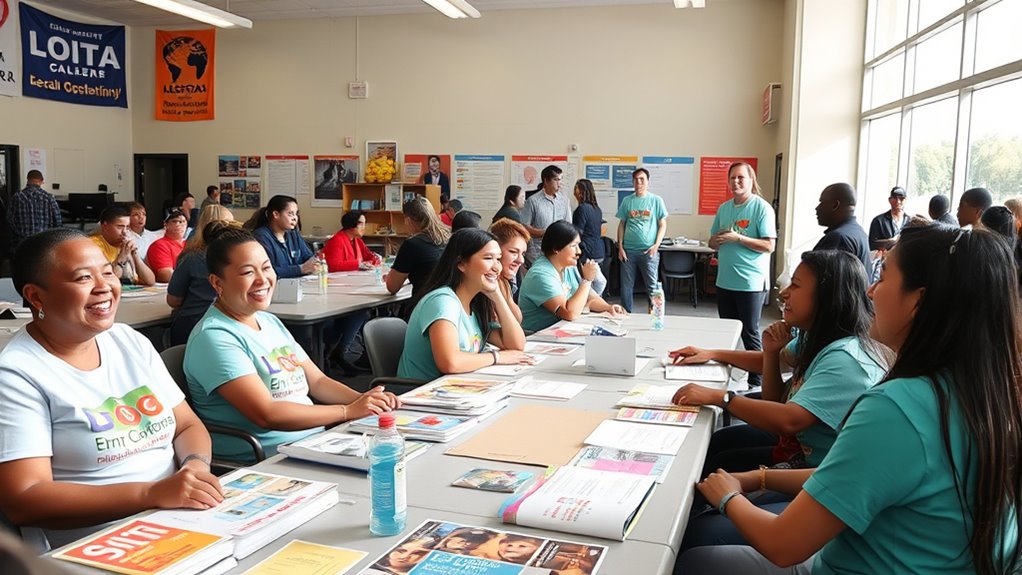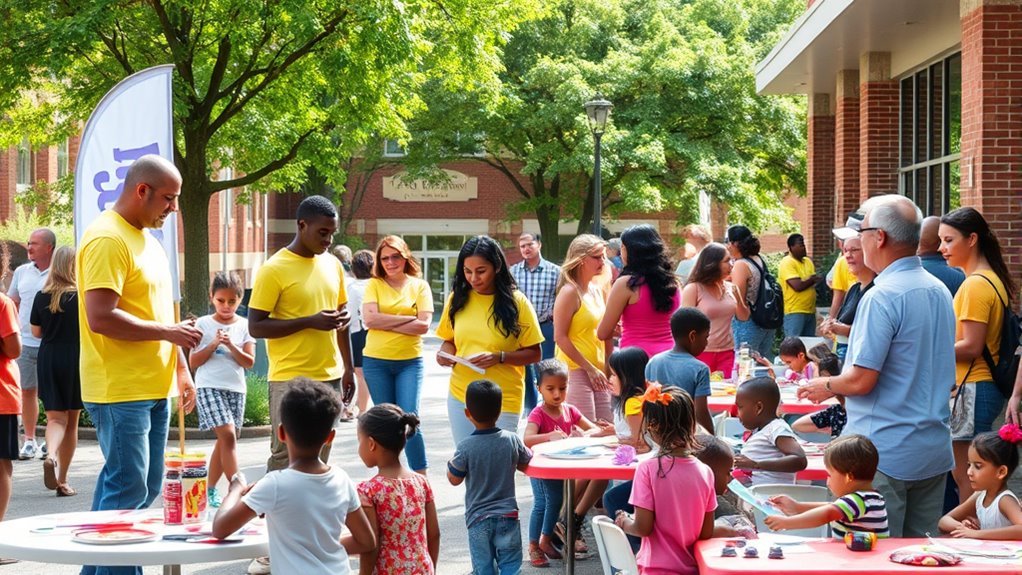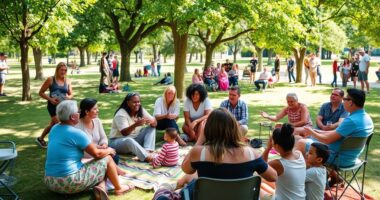Building strong community partnerships with local organizations can greatly boost your outreach efforts and create vibrant, resilient neighborhoods. By collaborating, you gain access to resources, expertise, and support systems that help address community needs effectively. Volunteer programs and resource sharing foster a sense of ownership and unity among residents. Establishing clear communication, trust, and mutual goals ensures these collaborations thrive. Keep going, and you’ll discover how these connections can transform your community into a lively, thriving place.
Key Takeaways
- Establish open communication and regular meetings to build trust with local organizations.
- Identify shared goals and values to create mutually beneficial partnership agreements.
- Engage community members in planning and decision-making processes for targeted outreach.
- Share resources like space, funding, and expertise to maximize impact and reduce duplication.
- Recognize and address challenges such as narcissistic behavior to strengthen collaboration efforts.

Community partnerships are essential for creating vibrant, resilient neighborhoods. When you collaborate with local organizations, you tap into a wealth of resources and expertise that can substantially boost your outreach efforts. One of the most effective ways to do this is through well-organized volunteer programs. By engaging community members in volunteer activities, you foster a sense of ownership and pride. Volunteers can help with everything from neighborhood cleanups to educational workshops, amplifying your reach without straining your resources. These programs not only mobilize residents but also build relationships that strengthen the community fabric. When you encourage volunteerism, you create a ripple effect, inspiring others to get involved and contribute to local causes. Recognizing and addressing underlying issues such as narcissistic behavior within community interactions can help foster healthier collaboration and communication.
Resource sharing is another crucial component of community partnerships. When organizations pool their resources—whether that’s space, funding, or knowledge—you maximize impact while minimizing costs. For example, a local nonprofit might share its community center for events hosted by a city agency or school. This approach reduces duplication and ensures that resources are used efficiently. Sharing resources also means you can offer more complete services to residents. If a health clinic partners with a food bank, they can provide both medical advice and nutritious food options, addressing multiple needs simultaneously. This coordinated effort makes your outreach more effective and sustainable. By fostering a culture of resource sharing, you show that working together creates a stronger, more adaptable neighborhood.
Building these partnerships requires proactive outreach and open communication. You should seek out local organizations that share your goals and values, and then establish clear, mutually beneficial agreements. Regular meetings and updates keep everyone aligned and motivated. When you involve community members in planning and decision-making, you ensure that initiatives resonate with local needs. This inclusive approach not only boosts participation but also creates a sense of collective ownership. As you nurture these relationships, you’ll find that collaboration becomes more natural, and the combined efforts lead to more impactful outcomes.
Ultimately, community partnerships thrive on trust and shared purpose. By developing volunteer programs and emphasizing resource sharing, you empower residents and organizations alike. These strategies help create neighborhoods that are not only more vibrant and lively but also resilient in facing challenges. When you work together, pooling your strengths and resources, you lay a foundation for a stronger, more connected community where everyone has a voice and a stake in the neighborhood’s future.
Frequently Asked Questions
How Do I Approach Potential Partner Organizations Effectively?
To approach potential partner organizations effectively, start by building trust through genuine conversations and understanding their goals. Tailor your outreach to highlight mutual benefits, showing how working together can address shared community needs. Be clear, respectful, and transparent about your intentions. Listen actively to their concerns, and demonstrate your commitment to a collaborative partnership. This personalized approach fosters a strong foundation for successful community engagement.
What Are Common Challenges in Forming Community Partnerships?
Imagine trying to build trust with a new partner, but conflicting priorities hinder resource sharing. Common challenges include establishing trust, aligning goals, and managing limited resources. You might face resistance or miscommunication that slows progress. To overcome these, focus on transparent communication, consistent engagement, and demonstrating mutual benefits. Trust building takes time, but it’s essential for effective community partnerships that maximize resources and create meaningful impact.
How Can I Measure the Success of a Partnership?
You can measure the success of a partnership through partnership evaluation and community impact measurement. Track progress against your goals, gather feedback from stakeholders, and assess tangible outcomes like increased community engagement or resource sharing. Look for improvements in community well-being and relationships. Regularly reviewing these metrics helps you determine if your partnership effectively serves its purpose and identifies areas for growth or adjustment.
What Funding Options Support Community Collaboration Initiatives?
You might think funding options are limited, but grant opportunities and sponsorship programs are excellent ways to support community collaboration initiatives. These options provide crucial resources to strengthen your outreach efforts. By actively seeking out and applying for relevant grants, and partnering with sponsors aligned with your goals, you can secure the necessary funds to expand your community impact. Don’t overlook these avenues—they’re essential for sustainable, successful collaborations.
How Do I Maintain Long-Term Partner Engagement?
To maintain long-term partner engagement, you should consistently build stakeholder trust by being transparent and reliable. Focus on fostering mutual benefits, guaranteeing all partners see value in the collaboration. Keep communication open, share successes, and listen to feedback. Regularly revisit goals to ensure alignment, and celebrate milestones together. This approach helps sustain relationships, encourages ongoing commitment, and strengthens your community partnerships over time.
Conclusion
As you reflect on building community partnerships, it’s no surprise how often the right connection shows up just when you need it most. Like that unexpected neighbor’s help or a chance meeting at a local event, these moments remind you that collaboration often happens when you least expect it. Keep your mind open and your heart ready—sometimes, the perfect partnership is just around the corner, waiting to turn your outreach efforts into something truly meaningful.










